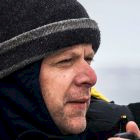Team members
Dr Mike Double – Chief Scientist

As a zoologist and geneticist, I lead the Australian Marine Mammal Centre (AMMC). We conduct scientific research that contributes to the conservation and management of marine mammals around Australia, through the Pacific and in Antarctic waters. Our Centre’s research leads the way in informing the world about all whale species.
Dr Elanor Bell – Deputy Chief Scientist / Biogeochemist

I am a microbial ecologist by training but have turned my hand from whale food to the whales themselves. On this voyage we’ll be doing the first in-field experiments to test the theory that whales fertilise the ocean with iron, after eating iron-rich krill and excreting the metal in their faeces. We’ll sample water in areas with whales and krill, whales only, krill only, and neither species.
Dr Karen Westwood – Voyage Project Manager / Biogeochemist

My research focusses on single celled organisms in the Southern Ocean called marine microbes (bacteria, phytoplankton, protozoa). These organisms are important for two main reasons: they form the base of the Antarctic food web, and they drive the biological pump in the Southern Ocean where up to 12% of anthropogenic CO₂ emissions are absorbed.
Dr Brian Miller – Whale Acoustician

To find the blue whales in the vast Southern Ocean, we’ll use small underwater listening devices called sonobuoys to locate and track them. These can detect the whale’s low frequency calls from up to 1,000 kilometres away. Real-time acoustic tracking provides a reliable and efficient way to find extremely rare Antarctic blue whales.
Dr Joshua Smith – Unmanned Aerial System Operator / Marine Mammal Observer

My main research interests focus on marine mammal behaviour and behavioural ecology, bioacoustics and spatial risk assessments. On this voyage, I will be leading the drone operations to obtain measurements and photo-identification of the whales.
Dr So Kawaguchi – Krill Ecologist

Using the RV Investigator’s multibeam echosounders, we want to develop the first 3D models of the shape, size, and density of krill swarms underwater, near whales and elsewhere. Krill swarms can be deep or shallow, dense or diffuse, but little is known about the different swarm types and whether some are more attractive to whales than others.

